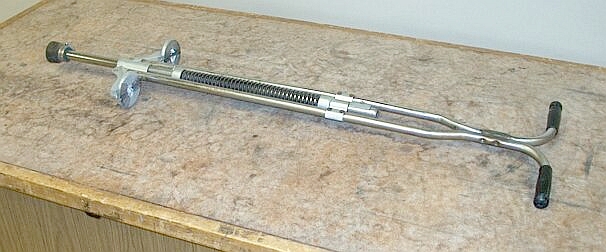
Bounce (or have a student bounce) up and down on the pogo stick to show the interconversion between potential and kinetic energy, and the work done by gravity, the spring and the pogo stick rider to keep the process going.
In demonstration 20.27 -- Launch sleeve with compressed spring, you press down on a brass collar to compress the spring beneath it, and then release the collar. The spring then relaxes to its original length, launching the collar into the air. In this demonstration, the spring is in the pogo stick, and by jumping on the footrests of the pogo stick, the person riding it compresses the spring, which then relaxes to its original length, launching the pogo stick and rider upward.
When you compress a spring, the force you exert to do so is F = kx, where x is the distance by which you have compressed the spring, relative to its free length, and k is the force constant of the spring. k is a measure of the stiffness of the spring, and its units are N/m. (The force the spring exerts in turn is F = -kx, which opposes the applied force to restore the spring to its original length. This is Hooke’s law.) The work you do in compressing the spring is W = ∫F · dx (= ∫kx dx). When we integrate, we find that W = (1/2)kx2. This is also the potential energy that is stored in the compressed spring. When the compressed spring relaxes to its original length, it does work on whatever is compressing it, in the process converting the potential energy into kinetic energy. If the object that had been compressing the spring comes free when the spring returns to its original length, then it moves away from the spring with a kinetic energy of (1/2)mv2, which is equal to the potential energy of (1/2)kx2. If the object and the spring stay together, and the other end of the spring is free, both the object and spring move together with a kinetic energy of (1/2)mv2, which is again equal to the potential energy of (1/2)kx2, but now m includes the mass of the spring as well as the mass of the object. (If, of course, the spring is much less massive than the object, we may neglect its contribution to the mass.)
When you jump onto the footrests (“pegs”) of the pogo stick, gravity has done work on you (after you have done work on yourself, against gravity, by jumping). You land on the footrests with kinetic energy, which now goes into compressing the spring, which continues until your downward velocity is zero. (You’ve done work on the spring.) When the spring is compressed, it now has potential energy equal to the kinetic energy that you had had when you landed on the footrests. The spring now returns to its original length, launching you and the pogo stick upward. (It does work on you and the pogo stick, after which all of the potential energy has been converted to kinetic energy.) You and the pogo stick rise until your kinetic energy has been converted into gravitational potential energy, at which point the tip of the pogo stick is several inches above the floor, and the cycle begins again.
If there were no friction, when you and the pogo stick fell back to the floor, you would compress the spring by the same amount as before, and in relaxing, the spring would launch you and the pogo stick to the same height as before. Because of energy loss due to friction, however, on each successive bounce the maximum height you reach would normally decrease. To overcome this loss from friction, each time you land you push down on the footrests. (On the way up, you bend your knees slightly, so that when you land, you can extend your legs.) In this way, on each bounce you add a little energy and keep the cycle going.
References:
1) Resnick, Robert and Halliday, David. Physics, Part One, Third Edition (New York: John Wiley and Sons, 1977), pp. 121-122.